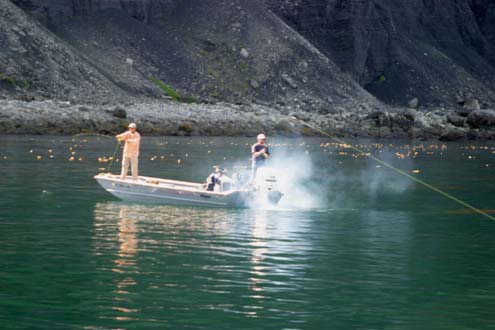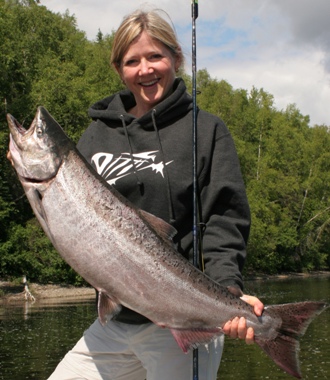
This blog post comes to us from Fish Alaska contributing editor Scott Haugen, whose many books on angling techniques and tactics are available through his website.
When you think about it, finding a king salmon in the ocean can be an overwhelming proposition. Here we are, anglers, situated in a boat, trying to not only find a salmon, but one that will bite. The sea is a big body of water, no doubt, but there are ways to narrow down the search, thereby increasing your odds of success.
While both king and coho salmon are sometimes caught in the same water, on the same setups, the behavior of the two fish are different, meaning anglers frequently must target specific types and depths of water in searching for regular migration routes. Knowing this, and factoring in such elements as tides and time of year, anglers can narrow down their search, to the point that catching fish in the ocean becomes routine.
Where to Start?
During initial daylight hours, kings are generally found feeding in 20 feet or less of water. Morning is also the time when the vast majority of bigger fish are caught by anglers, for the simple reason they are easier to find when feeding near the surface.
As the day progresses, kings move into deeper waters, often between 60- and 150 feet. Because kings occupy various sections of the water column, depth finders come in handy to help locate precisely where the fish are holding. If you don’t have a fish finder, there are various approaches you can take to locate kings.
Oftentimes, in areas that hold high numbers of staging fish or at certain times of the year, anglers will find themselves competing with coho when they’d rather be catching kings. When this happens, get that terminal gear down deeper, beneath the silvers.
In terms of reading the water and locating fish, rip lines can be valuable. Rip lines are where two ocean currents meet and can be located by searching for a line of floating debris, as well as changes in water color. Such lines contain baitfish, which are being kept there by the currents.
Trolling Approaches
When it comes to getting kings to bite, anglers have a wide-range of natural and artificial baits and presentations from which to choose. A common trolling approach is tying the mainline to a flasher, with a three- to four-foot long leader tied to the trailing end. Here, the flasher acts as a visual attractor and also gives action to the trolled herring. Ocean fish are not leader shy, and their sharp teeth warrant the use of a strong leader; 60-pound test is not overkill.
This setup is run off a downrigger, though it can be altered to run behind a diver of choice. If wishing to use a smaller flasher, simply run an 18-inch dropper behind a Luhr Jensen Deep Six or Double Deep Six diver. With a three-foot leader tied to the opposite end of the downsized flasher, and pulling a bait, this setup gives fish something different to look at.
If fishing multiple rods, it’s not a bad idea to vary the size of all the divers being used. Try running the larger divers toward the front of the boat, as they dig deeper. Run the smaller, shallower-running ones out the back. Not only will this keep the rods from getting tangled, but it’s a good way to find the depth at which the fish are holding.
Another effective trolling setup consists of a dropper and leader attached to a spreader. A dropper of eight to twelve inches is good, with two to six ounces of lead attached. This will keep the sinker and bait from getting tangled when trolled.
You can also rig your setup to fish inline. That means simply tying your mainline to a trolling sinker, the leader to the other end. Make sure the sinker has a bead chain swivel attached to it, so line twists can be avoided. Here, herring works well as bait, as do artificial presentations like the Mack’s Lure Sledge Hammer, one of my favorite squid imitations.
Stacked Downriggers
Downriggers take your terminal gear to the depths where kings hold and are perhaps the most common and effective way to reach these fish. For anglers intent on maximizing the fight, downriggers are the way to go, as less hardware is required. While trolling one rod per downrigger is the norm, it is possible to fish two rods at the same time.
To do this, let the line of the first rod out about 10 feet behind the boat, then clip it onto the downrigger wire. Send the downrigger down 25 feet and stop it. Now run a second fishing line out 10 feet behind the boat and clip it on to the same wire. You’re now running two fishing lines off the same downrigger, thereby targeting different depths.
This approach is great when searching for kings. Simply drop the lines as deep as you need to go until fish have been found. After 150 feet or so, this approach can be tough, as too much slack can be created in the lines.
Mooching
Dead-drift mooching and motor mooching are simple techniques that consistently produce kings. In dead-drift mooching, cut the engine, get your bait to the desired depth and drift with the tide, current or wind. If no waves are present to help move your bait, you’ll get an arm workout by constantly pumping the rod up and down, trying to emulate a crippled baitfish in hopes of capturing the attention of passing salmon.
Motor mooching involves putting your motor in gear and traveling at a slow pace. It’s not trolling, as trolling speeds are not attained. Motor mooching works well where tides are slight or currents slow, as it generates added action on the bait.
A basic mooching rig setup consists of a trolling sinker attached, inline, between the mainline and leader. Sinkers are often painted orange to help attract fish. Spreaders can also be used to separate the sinker and bait.
By expanding your ocean fishing approaches, the odds of catching more kings increase. Oftentimes this means nothing more than giving the fish something different to look at, or varying the speed or depth of the same presentation. With ocean season in full-swing, and plenty of kings out there, there’s no better time to hit the water and put your gear to the test.

